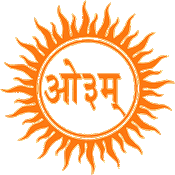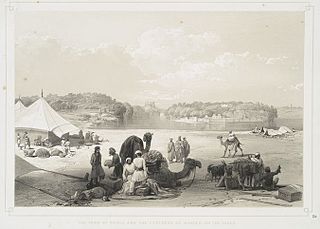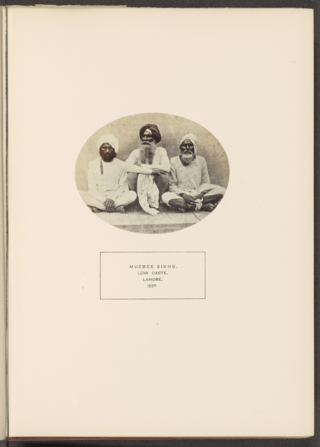Related Research Articles

Arya Samaj is a monotheistic Indian Hindu reform movement that promotes values and practices based on the belief in the infallible authority of the Vedas. The samaj was founded by the sannyasi (ascetic) Dayanand Saraswati in the 1870s.

Hinduism came to Mauritius when Indians were brought as indentured labour to colonial French and later in much larger numbers to British plantations in Mauritius and neighboring islands of the Indian Ocean. The migrants came primarily from what are now the Indian states of Bihar, Uttar Pradesh, Madhya Pradesh, Jharkhand, Maharashtra, Tamil Nadu, Telangana and Andhra Pradesh, with another influx of migrants from the Sindh region of Pakistan, following the Partition of India.

Arora is a community of Punjab, comprising both Hindus and Sikhs. The name is derived from their native place Aror. In 712, the Arora people left Aror and started to settle in the cities of Punjab.

Chamar is a Dalit community classified as a Scheduled Caste under modern India's system of affirmative action. They are found throughout the Indian subcontinent, mainly in the northern states of India and in Pakistan and Nepal.
Chuhra, also known as Bhanghi and Balmiki, is a Dalit caste in India and Pakistan. Populated regions include the Punjab region of India and Pakistan, as well as Uttar Pradesh in India, among other parts of the Indian subcontinent such as southern India. Their traditional occupation is sweeping, a "polluting" occupation that caused them to be considered untouchables in the caste system.
Ahir or Aheer are a community of traditionally non-elite pastoralists in India, most members of which identify as being of the Indian Yadav community because they consider the two terms to be synonymous. The Ahirs are variously described as a caste, a clan, a community, a race and a tribe.
Indo-Mauritians are Mauritians who trace their ethnic ancestry to the Republic of India or other parts of the Indian subcontinent in South Asia.
Ravidassia or the Ravidas Panth is a religion based on the teachings of Guru Ravidas. It was considered a sect within Sikhism until 2009. The Sikh gurus and the Guru Granth Sahib are considered reverential, but not central figures in the religion.

Mazhabi Sikh is a community from Northern India, especially Punjab region, who follow Sikhism. Mazhabi are part of wider category of Dalit Sikhs, who convert from the hindu Valmiki community. The word Mazhabi is derived from the Arabic term mazhab, and can be translated as the faithful. They live mainly in Indian Punjab, Rajasthan and Haryana.
Jatav or Ahirwar Jatav , also known as Jatava/Jatan/ Jatua/Jhusia /Jataau/Jatiya, is an Indian community that are considered to be a subcaste of Ravidassia/Chamar Community who are classified as a Scheduled Caste under modern India's system of positive discrimination. Jatavs mostly live in the states of Uttar Pradesh, Madhya Pradesh, Rajasthan, and boundaries of Haryana as well as the Union Territory of Delhi in northwest India.

Arya Samaj is a Hindu reform movement in South Africa. Like other parts of the world where people of Indian origin are settled, the teachings of Swami Dayananda Saraswati, founder of the Arya Samaj, made their way to South Africa during the beginning of the twentieth century. The Arya Samaj encouraged Indian South Africans to take pride in their heritage and culture and promoted education and social reform.
The Ramdasia were historically a Sikh, Hindu sub-group that originated from the caste of leather tanners and shoemakers known as Chamar.

Arya Samaj is a Hindu reform movement in Mauritius. Established in 1911, the Arya Paropkarini Sabha was officially registered in 1913. Since its creation Arya Samaj has had a great influence on the religious, social, educational and political lives of the people of Indian origin on the island. It has endeavoured to uphold the principles and ideals set forth by Maharishi Dayanand and his reformist movement. Some of the more notable ideals are women parity and free access to education. It has provided Hindus with a choice of progressive Hinduism, has promoted education with particular emphasis on Hindi and established orphanages, primary schools, colleges and tertiary institution.

Ravidas or Raidas (1267–1335) was an Indian mystic poet-saint of the Bhakti movement during the 15th to 16th century CE. Venerated as a guru in the modern regions of Uttar Pradesh, Bihar, Rajasthan, Gujarat, Maharashtra, Madhya Pradesh, Punjab, and Haryana, he was a poet, social reformer and spiritual figure.
Sanātana Dharma is an alternative name for Hinduism used in Sanskrit and other Indian languages alongside the more common Hindu Dharma.
Adi Dharm refers to the religion of Adi Brahmo Samaj the first development of Brahmoism and includes those Sadharan Brahmo Samajists who were reintegrated into Brahmoism after the second schism of 1878 at the instance of Devendranath Tagore. This was the first organised casteless movement in British India and reverberated from its heart of Bengal to Assam, Bombay State, Punjab and Madras, Hyderabad, and Bangalore.
Bihari Mauritians are the descendants of mainly Bhojpuri speaking migrants to Mauritius. A majority of Indo-Mauritians are of Bihari descent, and the majority of Mauritians are Indo-Mauritian. Castewise, most Bihari Mauritians are Vaishyas with significant Bhumihars, Brahmins, Rajputs, Koeris, Chamars, Yadavs, Kurmis, Banias and Kayasthas. All but one Mauritian Prime Ministers have been of Bihari Vaishya descent. The community includes a Hindu majority with a Muslim minority. About 65.7 % of the 1.3 million population of Mauritius is of Indian origin, most of them from Bihar, with Bhojpuri as their ancestral tongue.
Swami Achhootanand, also known as Achutanand or Hariharanand, was an Indian anti-caste intellectual, Dalit writer, and social reformer. A former Arya Samajist, he became disillusioned with the Arya Samaj and established the Adi Hindu movement. He was a poet, critic, dramatist, and historian.
Sanātanī is a term used to describe Hindu duties that incorporate teachings from the Vedas, Upanishads, Puranas, and other Hindu religious texts and scriptures such as the Ramayana and its many versions, as well as the Mahabharata, which itself is often described as a concise guide to Hindu philosophy and a practical, self-contained guide to life. The word Sanātanī is coined from Sanātana Dharma which refers to the idea that its origins lie beyond human history, as revealed in the Hindu texts.
Chandrika Prasad 'Jigyasu' (1880s/1890s—1974) was an Indian anti-caste intellectual, Hindi-language writer, and publisher of Dalit literature.
References
- ↑ "Understanding the caste system in Mauritius". 6 April 2021.
- ↑ http://mujournal.mewaruniversity.org/JIR%203-4/JIR3-4.pdf
- ↑ Claveyrolas, Mathieu (2015). "The 'Land of the Vaish'? Caste Structure and Ideology in Mauritius". South Asia Multidisciplinary Academic Journal. doi: 10.4000/samaj.3886 .
- ↑ The Legacy of Indian Indenture: Historical and Contemporary Aspects of Migration and Diaspora. Routledge. 10 November 2016. ISBN 9781351986830.
- ↑ New Homelands: Hindu Communities in Mauritius, Guyana, Trinidad, South Africa, Fiji, and East Africa. Oxford University Press, USA. 2010. ISBN 978-0-19-539164-0.
This article needs additional or more specific categories .(June 2023) |